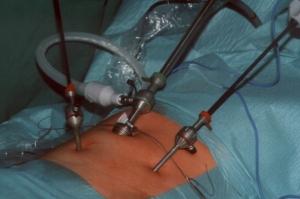 A hernia is caused by the weakening of muscles within the abdominal divider. It is a painful condition that can be seen both in youngsters and grown-ups. Hernias can occur as a result of hereditary conditions and/or poor lifting techniques.
A hernia is caused by the weakening of muscles within the abdominal divider. It is a painful condition that can be seen both in youngsters and grown-ups. Hernias can occur as a result of hereditary conditions and/or poor lifting techniques.
Because of failures within the abdominal divider some internal organs (particularly intestines) swell into the peritoneum. This type of reducible hernia is relatively uncomplicated. In many instances the organs can be manipulated back into position within the body. That said, even though these organs can be properly re-seated no one can guarantee they will remain in place without care.
Hernias occur when a portion of an organ projects through the solid fiber designed to keep the specific organ in place. It usually occurs as a result of poor muscle development around the organ. This allows the fiber to tear and the organ to protrude through the opening. Hernia usually create a prominent swollen area that can be seen with the naked eye.
Causes
If you suffer from a paraesophageal (adjacent to the esophagus) hernia you may experience intense epigastric pain that feels like strangulation. This relatively uncommon hernia is quite dangerous, even life threatening. Fortunately, this type of stomach strangulation does not occur in many cases.
Symptoms
Hernia symptoms are typically identified by the lump the hernia causes. In The early stages you only notice that little protuberance that does not hurt when it is touched. As the disease advances the herniation becomes quite painful as it continues swelling. The extrusion is quite noticeable when you hack or wheeze. In many cases the protrusion can be pushed back with your hand. However it will often pop back out within a few minutes. If the hernia cannot be pushed back then it’s quite likely you are suffering from a strangulated hernia.
Unlike paraesophageal hernias, hiatal hernias don’t cause noticeable symptoms and, in many cases, individuals suffering with this condition aren’t often aware of the hernia, which, for the most part, does not present any danger. The only time treatment is required is when strangulation happens.
If strangulation occurs the patient needs a medical procedure to return the stomach to its correct position. The strangulated hiatal hernia procedure is usually performed with a laparoscope, an instrument that allows the doctor to correct the problem without making a large incision.
Analysis
A hernia that breaks through the abdominal wall is usually diagnosed in later stages due to the absence of specific symptoms. Initial symptoms often resemble other stomach related illnesses.
Hiatal hernias are most common in persons 55 years and older, though they can theoretically happen at any age. It is caused by a weakening of the esophageal opening, allowing the upper part of the stomach to transit into the chest depression. This condition is known as a “rest hernia” and is often responsible for the condition known as gastric reflux.
Occurrence and treatment of umbilical hernia
Umbilical hernias that occur after birth in certain children usually shrink on their own by the time the child is 3 years old. Some mothers attempt to increase the speed of healing by tapping a coin on the lump and forcing the organ back into place. However, this method isn’t medicinally approved. In a few extraordinary cases umbilical hernias can be treated via hiatal hernia repair without surgery.
Shift Frequency © 2018 – Educational material
